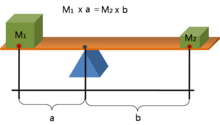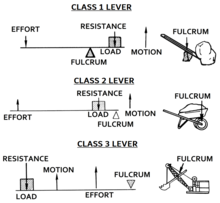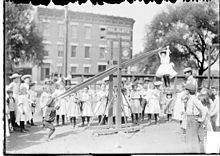Lever
A lever is a simple machine consisting of a beam or rigid rod pivoted at a fixed hinge, or fulcrum.On the basis of the locations of fulcrum, load, and effort, the lever is divided into three types.The verb, in turn, goes back to Latin: levare,[1] itself from the adjective levis, meaning "light" (as in "not heavy").The word's primary origin is the Proto-Indo-European stem legwh-, meaning "light", "easy", or "nimble", among other things.The PIE stem also gave rise to the English-language antonym of "heavy", "light".[3] The next earliest known cultural evidence of the application of the lever mechanism dates back to the ancient Near East c. 5000 BC, when it was used in a simple balance scale.[4] In ancient Egypt c. 4400 BC, a foot pedal was used for the earliest horizontal frame loom.[5] In Mesopotamia (modern Iraq) c. 3000 BC, the shadouf, a crane-like device that uses a lever mechanism, was invented.[4] In ancient Egypt, workmen used the lever to move and uplift obelisks weighing more than 100 tons.This is evident from the recesses in the large blocks and the handling bosses that could not be used for any purpose other than for levers.[6] The earliest remaining writings regarding levers date from the third century BC and were provided, by common belief, by the Greek mathematician Archimedes, who famously stated "Give me a lever long enough and a fulcrum on which to place it, and I shall move the world".That statement has given rise to the phrase "an Archimedean lever" being adopted for use in many instances, not just regarding mechanics, including abstract concepts about the sucessful effect of a human behavior or action intended to achieve results that could not have ocurred without it.[7] A lever is a beam connected to ground by a hinge, or pivot, called a fulcrum.The ideal lever does not dissipate or store energy, which means there is no friction in the hinge or bending in the beam.The mechanical advantage of a lever can be determined by considering the balance of moments or torque, T, about the fulcrum.This relationship shows that the mechanical advantage can be computed from ratio of the distances from the fulcrum to where the input and output forces are applied to the lever, assuming a weightless lever and no losses due to friction, flexibility, or wear.Levers are classified by the relative positions of the fulcrum, effort, and resistance (or load).Examples of compound levers include scales, nail clippers, and piano keys.The malleus, incus, and stapes are small bones in the middle ear, connected as compound levers, that transfer sound waves from the eardrum to the oval window of the cochlea.The lever is a movable bar that pivots on a fulcrum attached to a fixed point.The use of velocity in the static analysis of a lever is an application of the principle of virtual work.A lever is modeled as a rigid bar connected to a ground frame by a hinged joint called a fulcrum.The lever is operated by applying an input force FA at a point A located by the coordinate vector rA on the bar.Let the coordinate vector of the point P that defines the fulcrum be rP, and introduce the lengthswhere FA and FB are components of the forces that are perpendicular to the radial segments PA and PB.




Lever (disambiguation)Simple machinesimple machinesmechanical advantagemechanical advantage deviceEnglishOld FrenchProto-Indo-Europeandigging stickancient Near Eastbalance scaleancient EgyptMesopotamiashadoufhandling bossesArchimedesmomentstorqueseesawcrowbarscissorspliersclaw hammerwheelbarrownutcrackerbottle openerwrenchtweezershammerfishing rodmandibleCompound levermalleusstapesmiddle eareardrumoval windowcochleageneralized coordinategeneralized forcevirtual workApplied mechanicsBalance lever couplingbasculeLinkage (mechanical)Mechanism (engineering)On the Equilibrium of PlanesChisholm, HughEncyclopædia BritannicaSpringer Science & Business MediaGale ResearchCourier CorporationColumbia Journalism ReviewUsher, A. P.Stephen WolframWolfram Demonstrations ProjectInclined planePulleyWheel and axle